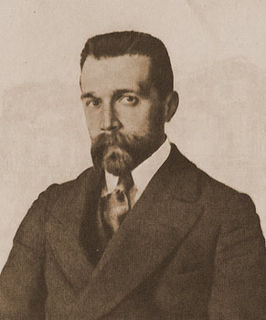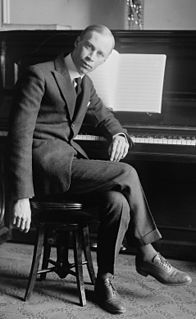Related Research Articles

Sergei Sergeyevich Prokofiev was a Russian Soviet composer, pianist and conductor. As the creator of acknowledged masterpieces across numerous music genres, he is regarded as one of the major composers of the 20th century. His works include such widely heard pieces as the March from The Love for Three Oranges, the suite Lieutenant Kijé, the ballet Romeo and Juliet—from which "Dance of the Knights" is taken—and Peter and the Wolf. Of the established forms and genres in which he worked, he created – excluding juvenilia – seven completed operas, seven symphonies, eight ballets, five piano concertos, two violin concertos, a cello concerto, a symphony-concerto for cello and orchestra, and nine completed piano sonatas.
A clarinet sonata is piece of music in sonata form for clarinet, often with piano accompaniment.

Nikolai Yakovlevich Myaskovsky or Miaskovsky or Miaskowsky, was a Russian and Soviet composer. He is sometimes referred to as the "Father of the Soviet Symphony". Myaskovsky was awarded the Stalin Prize five times, more than any other composer.

D major is a major scale based on D, consisting of the pitches D, E, F♯, G, A, B, and C♯. Its key signature consists of two sharps. Its relative minor is B minor and its parallel minor is D minor.
Sergei Prokofiev's Violin Sonata No. 1 in F minor, Op 80, written between 1938 and 1946, is one of the darkest and most brooding of the composer's works. Prokofiev was awarded the 1947 Stalin prize for this composition.
Sergei Prokofiev's Violin Sonata No. 2 in D Major, Op. 94a, was based on the composer's own Flute Sonata in D, Op. 94, written in 1942 but arranged for violin in 1943 when Prokofiev was living in Perm in the Ural Mountains, a remote shelter for Soviet artists during the Second World War. Prokofiev transformed the work into a violin sonata at the prompting of his close friend, the violinist David Oistrakh. It was premiered on 17 June 1944 by David Oistrakh and Lev Oborin.
Sergei Prokofiev's Piano Sonata No. 7 in B♭ major, Op. 83 (1942) is a sonata composed for solo piano, the second of the three "War Sonatas". The sonata was first performed on 18 January 1943 in Moscow by Sviatoslav Richter.
Sergei Prokofiev's Piano Sonata No. 6 in A major, Op. 82 (1940) is a sonata for solo piano, the first of the Three War Sonatas. The sonata was first performed on 8 April 1940 in Moscow.

Sergei Prokofiev's Piano Sonata No. 8 in B♭ major, Op. 84 (1944) is a sonata for solo piano, the third of the Three War Sonatas. The sonata was first performed on 30 December 1944 in Moscow by Emil Gilels.
The Flute Sonata in D, Op. 94, was a musical work that was composed by Sergei Prokofiev in 1943. It was initially made for flute and piano, and was later transcribed for violin as Op. 94a. Both versions have been recorded several times.
Violin Sonata, a composition for violin and piano, is a work of the Czech composer Leoš Janáček (1854-1928). It was written in the summer of 1914, but it was not Janáček’s first attempt to create such a composition. He resolved to compose a violin sonata already as a student at the conservatoire in Leipzig in 1880, and later during his studies in Vienna. His early sonatas are today lost.
Olli Mustonen is a Finnish pianist, conductor and composer.
Sergei Prokofiev's Piano Sonata No. 4 in C minor, Op. 29, subtitled D’après des vieux cahiers, or After Old Notebooks, was composed in 1917 and premiered on April 17 the next year by the composer himself in Petrograd. The work was dedicated to Prokoviev's late friend Maximilian Schmidthof, whose suicide in 1913 had shocked and saddened the composer.
Sergei Prokofiev's Piano Sonata No. 2 in D Minor, Op. 14 (1912), is a sonata composed for solo piano. It was premiered on February 5, 1914 in Moscow with the composer performing. Prokofiev dedicated the work to his friend and fellow student at the St. Petersburg Conservatory, Maximilian Schmidthof, who committed suicide in 1913.
Sergei Prokofiev's Piano Sonata No. 3 in A minor, Op. 28 (1917) is a sonata composed for solo piano, using sketches dating from 1907. Prokofiev gave the première of this in St. Petersburg on April 15, 1918, during a week-long festival of his music sponsored by the Conservatory.
Sergei Prokofiev's Piano Sonata No. 5 in C Major, Opus 38, was written at Ettal near Oberammergau in the Bavarian Alps during the composer's stay there in 1923. He would revise it thirty years later, at the end of his life, but not drastically, as his Opus 135, and it is this version that is usually played. The work is dedicated it to Pierre Souvtchinski, a musicologist and friend. All eight of Prokofiev's other piano sonatas were written in Russia. The revisions to this piece, made in 1952-53 in Russia, are mostly in the last movement.
Sergei Prokofiev's Piano Sonata No. 1 in F minor, Op. 1 was written in 1909. It consists of a single movement in sonata form.
Sergei Prokofiev's Piano Sonata No. 9 in C major, his Opus 103, was composed in 1947 and dedicated to Sviatoslav Richter, a member of the Union of Soviet Composers, who gave its first performance on 21 April 1951 in Moscow.
Sergei Prokofiev's Piano Sonata No. 10 in E minor, Op. 137 (1952) (unfinished) is a sonata composed for solo piano.

Barbara Nissman is an American pianist. She is especially known for her interpretations and performances of the works of Alberto Ginastera and Sergei Prokofiev which feature prominently in her repertoire. She is also a writer and a producer of a new DVD series, and a guest clinician presenting concerts, master classes and lectures world-wide.
References
- ↑ Sorensen, Sugi (2005). "The Prokofiev Page - Piano Sonata 11 (unrealised)". Allegro Media. Archived from the original on 22 May 2011. Retrieved 10 April 2012.